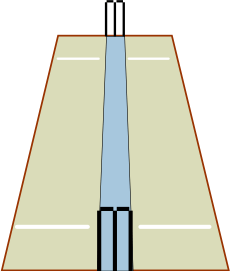Leg before wicket facts for kids
Leg before wicket (often called LBW) is one way a cricket player, called a batsman, can get out. For an LBW to happen, the fielding team must ask the umpire to make a decision. The umpire then decides if the batsman is out.
An LBW happens when the ball hits the batsman's body (usually their leg or pad) before it touches their bat or hand. If the ball would have hit the wicket (the stumps behind the batsman) but was stopped by the batsman's body, they might be out LBW.
This rule was first added to cricket in 1774. Players started using their pads to block the ball from hitting the wicket, so this rule was made to keep the game fair.
Contents
What is Leg Before Wicket?
The official rules for leg before wicket are in Law 36 of the Laws of Cricket. These rules are written by the Marylebone Cricket Club (MCC).
How an LBW is Decided
First, the team playing in the field must ask the umpire to make a decision. This is called an "appeal." If the bowler bowls a no-ball (an illegal delivery), the batsman cannot be out LBW.
Otherwise, for the batsman to be out LBW, these things must happen:
- The ball, if it bounces, must hit the ground either in line with the wickets or on the "off side" of the wickets.
- The "off side" is the right side of the pitch for a right-handed batsman.
- It is the left side of the pitch for a left-handed batsman.
- The ball must hit the batsman's body without first touching their bat.
- The batsman's bat includes their hands holding it.
- The ball must have been going on to hit the wickets.
When a Batsman Doesn't Try to Hit the Ball
A batsman can also be out LBW if they do not try to hit the ball with their bat. This happens if:
- The ball hits them outside the line of the "off stump."
- The ball would have still hit the wickets if the batsman wasn't there.
The umpire has to imagine the ball would keep going in the same direction. This is true even if the ball would have bounced again before hitting the stumps.
Using Technology for LBW Decisions
Sometimes, umpires use video replays and other technologies to help decide if a batsman is out LBW. These tools help make sure the decision is fair and accurate.
Types of Technology Used
- Hot Spot: This technology uses heat to show exactly where the ball touched the bat or the batsman's body. It creates a visual mark on the screen.
- Snickometer: This tool uses sound to detect if there was a tiny noise when the ball hit the bat. This can show if the ball touched the bat very lightly.
- Hawkeye: This is an advanced computer simulation. It predicts where the ball would have gone after hitting the batsman's body if the batsman had not been there. This helps the umpire see if the ball was heading for the wickets.
Images for kids




